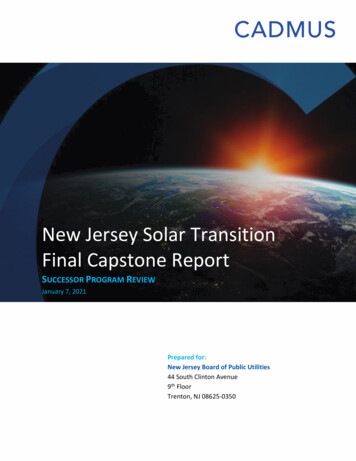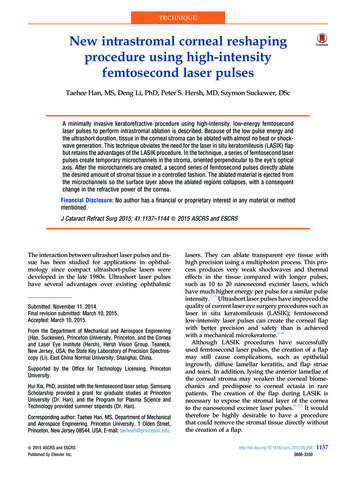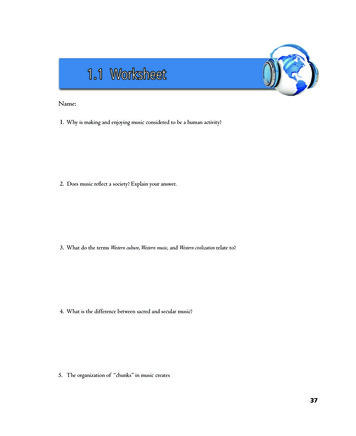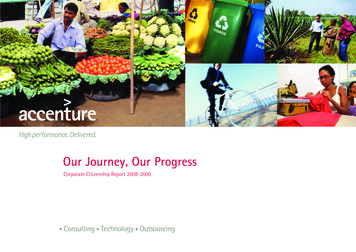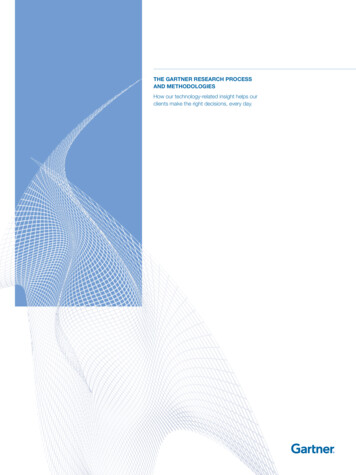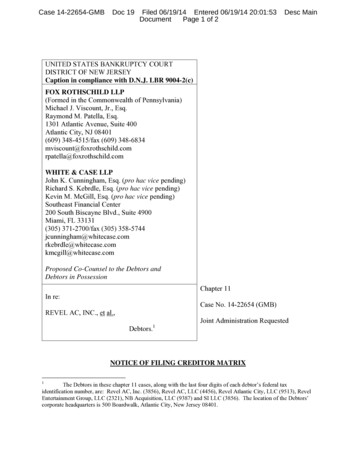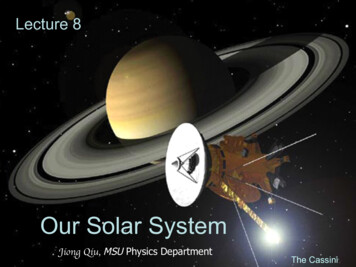
Transcription
Lecture 8Our Solar SystemJiong Qiu, MSU Physics DepartmentThe Cassini
Guiding Questions1. Are all the other planets similar to Earth, or are they verydifferent?2. Do other planets have moons like Earth’s Moon?3. How do astronomers know what the other planets aremade of?4. Are all the planets made of basically the same material?5. What is the difference between an asteroid and a comet?6. What determines whether a planet or satellite can retaina certain gas in its atmosphere?7. Why do interplanetary spacecraft carry devices formeasuring magnetic fields?
Current, Future, and Past Solar System MissionsPlanetary exploration missions are conducted by someof the most sophisticated robots ever built. Through themwe extend our senses to the farthest reaches of the solarsystem and into remote and hostile environments, wherethe secrets of our origins and destiny lie hidden. Thecoming years of solar system exploration promise to bethe most exciting and productive yet, as we exploreentirely new worlds and probe in even greater detail thefascinating environments we have discovered.
We will learn the motion, structure, atmosphere,magnetic field of the Sun, planets, and satellites,and how to observe them.We will learn how to explain them -- gravity,energy, and nature of light.We will learn why our planet, the Earth, hostslife.
Solar SystemMercury, Venus, Earth, Mars, Jupiter, Saturn, Uranus, Neptune, (Pluto).(MVEMJSUN – My Very Easy Method Just Seems No Use)q The star we call the Sun and all the celestial bodies that orbitthe Sunn n n including Earth and other seven planetsall their various moonssmaller bodies such as asteroids, comets, meteoroids and dust
8.1 PlanetsAccording to their orbits,planets fall into two classes:the inner planets (Mercury,Venus, Earth, and Mars) areEarthlike, and the outerplanets (Jupiter, Saturn,Uranus, and Neptune) areJupiter like.
the terrestrial (inner) planetsThe four inner planets are called terrestrial planets– Relatively small: Earth is the largest– Low mass: Earth is the heaviest– High densities (4000 to 5500 kg/m3) with iron cores– Composed primarily of rocky materials with solidsurface
the Jovian (outer) planetsThe four gas giant outer planets are called Jovian planets– Large diameters (4 to 11 times Earth’s size)– High mass (14 to 318 times Earth’s mass)– Low average densities (700 to 1700 kg/m3)– Composed primarily of hydrogen and helium without asolid surfaceJupiter is the largest and the most massive!
Pluto – special case: no longer a planet!Pluto is a special case– Smaller thanany of theterrestrialplanets– Intermediateaverage densityof about 1900kg/m3– Its densitysuggests it iscomposed of amixture of iceand rockDistance and size, drawn to scale.
Q: how do we know the composition of planets?The average density gives a rough idea of the compositionof a planet.MMρ 4VπR 33ρ density, M mass of the objectV volume of the object 4 π R3 / 3 (for spheres)R radius of the spherical object Average density of water: ρwater 1000 kg/m3 Average density of metal: ρmetal 13,000 kg/m3 Average density of rock: ρrock 3000 kg/m3The terrestrial planets (ρ 4000-5500 kg/m3) are made ofrocky materials and have dense iron cores.The Jovian planets (ρ 700-1700 kg/m3) are composedprimarily of light elements such as hydrogen and helium.
8.2 satellites, asteroids, and cometsEarth’sdiameteris 12,800kilometer,twice thatof Titan.- All the planets except Mercury and Venus have satellites.- More than 130 satellites are known. Jupiter has more than 60.- Seven large satellites are almost as big as the terrestrial planets. Comparable in size to the planet Mercury- Ganymede and Titan are the largest; Titan has an atmosphere. The remaining satellites of the solar system are much smaller
Asteroids are small rocky objects, orbiting the Sun atdistances of 2 to 3.5 AU in the asteroid belt’, betweenMars and Jupiter.Asteroidsin thedistanceby HST.(R. Evans, &K.StapelfeldtJPL)Hubble Space Telescopeobserved rotation of the miniplanet Ceres, the largestasteroid (diameter 900 km)in the asteroid belt. Water mayexist beneath its surface.Asteroid 433 Eros
- Comets and other Kuiper belt objects are made of dirty ice.- The Kuiper belt extends far beyond the orbit of Neptune.- Pluto is the largest member of the Kuiper belt.Comet Hale-BoppComet HalleyCopyright of the UK Schmidto Both ateroids and cometsare remnants left over fromthe formation of theplanets.o They all orbit around theSun, following Kepler’slaws.o Like the two categories ofplanets, asteroids are more“terrestrial”, comets are“Jovian”.
asteroid beltsKuiper belt andOort cloud
Q: What’s the difference between planets,satellites, asteroids, and comets?1. Satellites orbit around planets, planets orbit the Sun.2. Asteroids and comets also orbit the Sun, butthey are not large enough to become planets.3. Asteroids locate in the asteroid belt betweenMars and Jupiter. Comets are in Kuiper beltbeyond Neptune.4. Comets are likely extra-solar system objects!
8.3 Orbits of Planets - Kepler’s laws Most planets orbit the Sun inthe same direction and in almostthe same plane: ecliptic is theplane of the Earth’s orbit. Most planets have nearlycircular orbits - the eccentricityof the orbit is very small. The farther away from the Sun,the longer the orbital period:(from Arizona State U.)Kepler’s third law: P2 a3(P sideral period, in year, a semimajor axis of orbit, in AU)Ex.1 Saturn’s distance to the Sun is about 10 AU. A yearon Saturn is as long as how many Earth year?
Newton/Kepler’s law determines the planet massNewton’s Law of Universal Gravitation accounts forKepler’s laws and explains the motions of a binary system.mMFG G 2rF gravitational force between two objects (in newtons)m mass of the planet (in kilograms)M mass of the Sun (in kilograms)r distance between planet and Sun (in meters)G 6.67 10–11 newton m2/kg2 , universal constant ofgravitation
Newton’s form of Kepler’s third lawThe gravitational (pull orattractive) force keeps theplanets orbiting the Sun.24πmr2F mω r FG2P Newton demonstrated thatKepler’s third law followslogically the law of gravity,and can be re-written as:# GM & 2a % 2 (P 4π '3P sidereal period, in secondsa semimajor axis, in metersM mass of the Sun, in kgG universal constant of gravitation 6.67 x 10-11This same relation is used to describe a satellite orbiting a planet.
P2 a3The further away from the sun, the longer it takes to finish oneorbit. Kepler’s law also applies to asteroids and comets, allsolar system objects that orbit the Sun.Newton’s law of the universal gravitation accountsfor Kepler’s laws.
Newton’s form of Kepler’s third lawThe gravitational (pull orattractive) force keeps theplanets orbiting the Sun.24πmr2F mω r FG2P Newton demonstrated thatKepler’s third law followslogically the law of gravity,and can be re-written as:# GM & 2a % 2 (P 4π '3P sidereal period, in secondsa semimajor axis, in metersM mass of the Sun, in kgG universal constant of gravitation 6.67 x 10-11Scaling the equation to Sun-Earth system: Kepler’s third law.
8.4 The atmosphere is retained by gravityWhether gases can stay in a planet’s atmosphere depends onthe combination of the following three factors:o planet’s mass and size: gravity can retain gas particles.o gas composition: light gases run faster than heavy gases.o temperature: gases at higher temperature run faster.When an object has a high enough speed, it can escape fromthe planet’s gravity (think about how we launch a rocket). Theescape speed is:v esc 2GMR(see Box 7.2 forescape speed ateach planet)M mass of the planet(kg); R radius of the planet(m);G gravitational constant 6.67 x 10-11 N m2/kg2.
The average speed of a gas at a temperature is given as:1/ 2m gas mass(kg);" 3kT %v th '# m &(thermal speed)T temperature (K kelvins);vth speed (m/sec);k Boltzmann constant 1.38 x 10-23 J/K (optional) Maxwellian distribution of particles in thermalequilibrium.A good thumb rule goes:If 6 vth vesc , the particles (atoms or molecules) escape.If 6 vth vesc , the particles (atoms or molecules) stay!
1/ 2" 3kT %6v th 6 '# m & v esc 2GMRHigher temperature, less likely to retain a gas.Gas particles with smaller mass (m), less likely to be retained. Planet of larger mass (M), more likely to retain a gas.Q: among 8 planets, 1 does not have appreciableatmosphere. Which one and why?Terrestrial planets: high temperature, weak gravity, so lowmass gases escape and massive gases stay.Jovian planets: low temperature, strong gravity, can retaineven very light gases, e.g., hydrogen and helium.Gravity and distance to the Sun are crucial!
escape temperature:T esc1 GMm 54 kREx 2: compare the abilities of Earth and the Moon to retainmolecular oxygen (O2) gas in the atmosphere. (see Box-7.2) We may calculate the escape temperature for molecularoxygen on Earth and on the Moon. For Earth, Tesc 4500K, much greater than Earth’s mean temperature. And forthe Moon, Tesc 200 K, smaller than the Moon’s meantemperature. Therefore, molecular oxygen gas is retainedon Earth but not on the Moon.Q: among 7 largest satellites in the solar system,Titan is the only one with an appreciableatmosphere. Why is that?
8.5 CompositionThe average density gives a rough idea of the compositionof a planet.MMρ 4VπR 33ρ density, M mass of the objectV volume of the object 4 π R3 / 3 (for spheres)R radius of the spherical object Average density of water: ρwater 1000 kg/m3 Average density of metal: ρmetal 13,000 kg/m3 Average density of rock: ρrock 3000 kg/m3The terrestrial planets (ρ 4000-5500 kg/m3) are made ofrocky materials and have dense iron cores.The Jovian planets (ρ 700-1700 kg/m3) are composedprimarily of light elements such as hydrogen and helium.
Spectroscopy more accurately reveals the chemicalcomposition of surface and atmosphere of planets. The spectrum of a planet or satellite with an atmospherereveals the atmosphere’s composition. If there is no atmosphere, the spectrum indicates thecomposition of the surface. The substances that make up the planets can beclassified as gases, ices, or rock, depending on thetemperatures at which they solidify. The terrestrial planets are composed primarily of rockymaterials, whereas the Jovian planets are composedlargely of gas.
Atmosphere compositionEx 3: Atmosphere of Titan – Methane is dominantAbsorption features reveal the atmosphere composition.The amount of absorption depends on the abundance of theelements and temperature and density of the atmosphere.
Formation of Titan Spectra
Ex.4 Moonshine and earthshine spectra reflectingatmosphere propertiesAtmosphere molecular line:oxygen A bandsSolar line: H-alpha line
Ex.5: Additional sodium absorption found in thespectroscopy data of the planet transit shows evidence ofHD 209548b having an atmosphere. Credit: SpaceRef.com
Surface CompositionEx 6: Surface of Europa - Ice dominatedA solid surface,unlike anatmosphere,does notproduce sharpspectral lines.The broad absorption and reflection spectrum ofJupiter’s moon Europa compared with ice.
Hydrogen and helium are abundant on the Jovianplanets, whereas the terrestrial planets arecomposed mostly of heavy element.MarsJupiterSurface composition
8.6 Cratering and ageCratering on planets and satellites is the result of impactsfrom interplanetary debriso When an asteroid, comet, or meteoroid collides with the surfaceof a terrestrial planet or satellite, the result is an impact crater.o Geologic activity renews the surface and erases craters, so aterrestrial world with extensive cratering has an old surface andlittle or no geologic activity.Craters on Moon, Earth, and Mars.
8.7 Magnetic fieldsA planet with a magnetic field indicates a fluid interior in motion.The magnetic fields of abar magnet. Planetary magnetic fieldsare produced by the motionof electrically conductingliquids inside the planet. This mechanism is called adynamo. If a planet has no magneticfield, that is evidence thatthere is little such liquidmaterial in the planet’sinterior or that the liquid isnot in a state of motion.
The magnetic fields ofterrestrial planets areproduced by metals such asiron in the liquid state. Mercury and Earth haveglobal magnetic field.EarthMars Mars has magnetizedregions. Magnetic field is not found inVenus, maybe due to its slowrotation.
Jupiter’s strongmagnetic fieldinteracting withsolar wind.(NASA) The stronger fields of the Jovian planets are generated byliquid metallic hydrogen (Jupiter & Saturn) or by water withionized molecules dissolved in it (Uranus and Neptune). Jupiter, Saturn, Uranus and Neptune all have globalmagnetic field. Jupiter has the strongest magnetic field among all planets.
How to determine properties of the planets? orbit period: direct observation distance: parallax, Kepler’s third law diameter: direct observation of angular size, and smallangle formula mass: Newton’s form of Kepler’s third law density: mass/volume chemical composition: density, spectroscopicobservation (can diagnose atmosphere and surfacecomposition) magnetic fields: magnetometer observation, radioobservation internal structure: inferred from craters, magnetic fields,quakes
Gravity and distance to the Sun are the keysto understanding the solar systemcompositiondistanceorbit periodtemperatureatmospherestate of mattermass/sizeinternal heatrotationmagnetic fieldsurfacegeologicalactivityQ: Where does GRAVITY spell out?Our knowledge of the Universe criticallydepends on how much we understand LIGHT.
Key Words asteroidasteroid beltaverage densitychemical compositioncometdynamoescape speedicesimpact craterJovian planet kinetic energyKuiper beltKuiper belt objectsliquid metallic hydrogenmagnetometermeteoroidminor planetmoleculespectroscopyterrestrial planet
summary Planets are categorized as terrestrial and Jovian planets.The terrestrial planets are small inner planets, and Jovianplanets are large outer planets. The terrestrial planets are rocky, dense, made of heavyelements, and the Jovian planets are gaseous and made ofhydrogen, helium or ice. All planets but Mercury and Venus have satellites. Asteroids and comets are small objects orbiting around theSun in asteroids belt (between Mars and Jupiter) or Kuiperbelt. Asteroids are “terrestrial” and comets are “Jovian”. Whether a planet has a certain gas in the atmospheredepends on the temperature and gravity on the planet andthe mass of the gas, which determine whether the gas canescape. Presence of magnetic fields reflects motion of electricallyconducting liquids inside the planets.
o planet’s mass and size: gravity can retain gas particles. o gas composition: light gases run faster than heavy gases. o temperature: gases at higher temperature run faster. When an object has a high enough speed, it can escape from the planet’s gravity (

